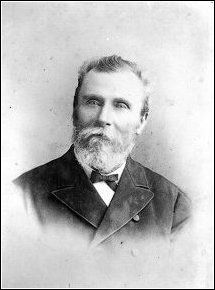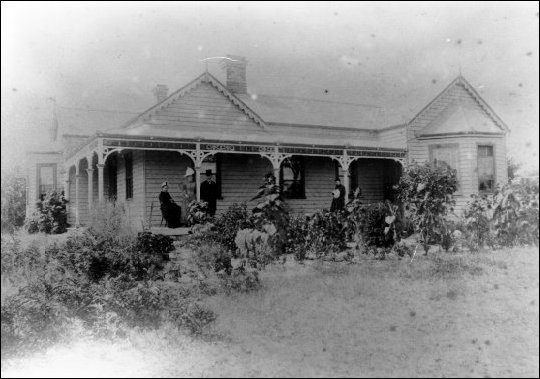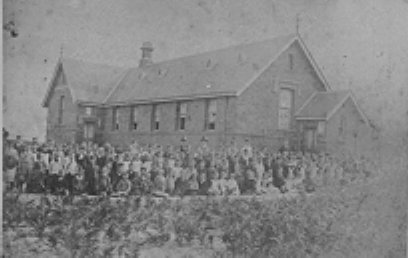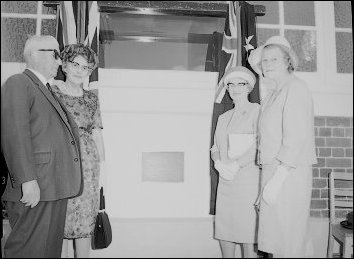Walter Meeres: Pioneer Headmaster

Walter Meeres. From Leader Collection.
The brothers Meeres both had important roles to play in the history of State School No 84. Both were involved in the school that was the forerunner to a new primary school now located in Charman Road, Cheltenham. One became the first headmaster of this new school which was originally known as Beaumaris but later was called Cheltenham.
Frederick, the elder brother, founded a private school in La Trobe Street on what was called the Beaumaris Estate. He purchased seven blocks of land from Josiah Morris Holloway and on the two blocks in La Trobe Street he built his house and established a school. The remaining five blocks were on the government road which later was named Balcombe Road.
Public schools in the 1850’s were administered by either the National Schools Board or the Denominational Schools Board and it was through these boards that money was provided for teachers’ salaries and building construction. On July 1, 1855 Meeres’ school officially became a Wesleyan school under the supervision of the Denominational Board.[1] This school began with 36 pupils with an average attendance of 22 for the six months. Frederick Meeres’ salary for that period was £38-15-0.[2]
In 1862 the educational administration of the colony of Victoria was reorganised with the disbandment of the National and Denominational school boards and the creation of the Board of Education to regulate public education. Each school that received State aid through the Board of Education was known as a Common School. Frederick Meeres’ school in La Trobe Street became Beaumaris Common School No 84.[3]]
Frederick and his wife remained at Beaumaris until 1864 when according to William Bruton, "business called them back to the old country"[4] Yet the shire rate records for 1868 show Frederick Meeres as the occupier of a property on Point Nepean Road owned by Charles Tuck. This suggests that the return to England of Frederick and his wife was not immediate.
John Chambers became the headteacher of Beaumaris No 84, occupying the property in La Trobe Street in 1865. The following year he purchased the property from Frederick Meeres for £150. William Bruton recalled Chambers as a person whose "principle object was the constant use of the cane, several of which he kept in stock, his favorite (sic) one being, as he called it, his yellow tongue, the use of it being his chief delight. … Mr Chambers essayed to teach a singing class, but I knew of a bull that seemed to know nearly as much of music, and could sing nearly as well." John Chambers appointment was short as he retired from teaching in 1865 due to ill health. Chambers replacement was Charles Tranter who according to Bruton was very popular but he too did not stay very long "having been offered a more remunerative position elsewhere." [5]
Walter Meeres, the brother of Frederick resumed the Meeres connection with the school when he was appointed headmaster on July 2, 1866. The record of his appointment shows his age as 40 years. A report published in the Moorabbin News in 1966 said, "Meeres was born in England where, while still a child lost both his parents. He went to sea for a while then, visiting relatives in India, he joined the Indian Army. Later he came to Australia and settled in Cheltenham."[6]
In 1861 at Cheltenham he met and married Emily Margaret Walker whose father, Thomas Walker, lived in Chesterville Road, Cheltenham. In the Rate Book of the Shire of Moorabbin of 1862, Walter was listed as living in Balcombe Road on a property which he owned. Subsequent records in the rate books suggest he and his family remained on that property until 1868. In 1870 the same records show that while the property was still owned by Walter, the occupier was William Hatherly.
William Percy Fairlam, as a young boy, lived on the Balcombe property with Walter Meeres and his wife Emily . When an old man he recalled, "I lived with my Uncle and Aunt in an Egyptian-style brick home erected on the corner of the present Swanston Street and Balcombe Road. … The house had been built of sun-dried bricks set with clay and straw."[7] During their stay at this residence several of the ten Meeres’ children were born and two died
From Balcombe Road, Walter and his family moved to Elizabeth Street where according to rate records they occupied a seven room house on a two acre property. For the following three years, rate records give Collins Street as the Meeres’ address. Because roads were not well defined at that time and could more accurately be described as tracks the same property was often listed at different locations by different people. Whether this is the Elizabeth Street property with a new entrance in Collins Street cannot be determined from the rate records.
While retaining ownership of the Collins Street property, by 1877 the family were living at Latrobe Street on the land originally purchased by Frederick Meeres. Although conducting the school on this site from 1866 Walter did not purchase the property from John Chambers until April 20, 1869. He paid £110.[8] Walter and his family remained on this site until 1881 when it was reduced in size from three acres to one acre with the construction of the Melbourne to Frankston railway line. "On 4th August 1881 Walter made what was, in those times, a small fortune by selling at portion of the land to the Board of Land and Works for £475. This portion was triangular in shape, and was required for completion of the railway from Moorabbin to Frankston. The remaining land was sold for only £35 (to James Brough), indicating that the original house had to be demolished in order to sub-divide the land, and the remainder was thus sold for land value only." [9]

Merrivale, Charman Road, Cheltenham. Photograph, courtesy Betty Kuc.
By 1882 the Meeres’ were living in a six roomed house, Merrivale, on four acres in Charman Road. Brownbill wrote that the house was in Bourke Road but reached by a long drive from Charman Road. [10] Later the family went to live in a house opposite the school in Charman Road where Mrs Meeres kept a shop. "On one side she sold drapery - nun’s veiling, galatea, hailspot, muslin, madapolam and cashmere stockings, on the other, school books, slates, pencils and lollies."[11] After his retirement from teaching Walter undertook the task of Registrar of Births and Deaths for the district. In retirement he spent a good deal of time at his hobby, astronomy, going down to the beach in his long tussore silk coat to study the stars and summer evenings.
Shortly after Walter Meeres’ appointment in 1866 as headmaster of the Beaumaris School, then located in La Trobe Street, the correspondent of the school committee wrote to the Board of Education requesting assistance in providing more accommodation because of increased enrolments. As the community could not raise sufficient funds to meet the costs it was proposed that their school should be amalgamated with a school in Cheltenham and a new building be erected on a new site. This proposal did not receive universal support from people living in the district. Indeed, the community associated with the Cheltenham school, which was affiliated with the Church of England, strongly opposed the suggested amalgamation and fought it vigorously.
The battle between the two groups went on for many years with petitions and counter petitions being circulated, and correspondence flowing between the correspondents of the two parties and the Education Department. Although Walter Meeres was not an official correspondent he was actively involved. A petition from forty Beaumaris parents advocating the establishment of a new school on the "Government Reserve Site in Charman Road" as the most suitable situation is written in a copperplate hand by Walter Meeres.[12]
After an investigation by Inspector Brown, the Board of Education informed the Cheltenham school community that it was "inexpedient to maintain two schools so near to each other as Cheltenham and Beaumaris and unless they are willing to amalgamate with Beaumaris, aid will be withdrawn."[13] In addition, a note on the file says, "The site the Board approves of is in the Charman Road near the Cemetery." These decision by the Board caused lingering resentment.
The Cheltenham School No 127 continued for a short time as a private enterprise under Miss Gott but was subsequently closed. A new brick school consisting of two rooms was built on the Charman Road site at a cost of two hundred pounds one shilling and two pence, half of the cost being raised locally. Walter Meeres was appointed headmaster of the new school carrying the name Beaumaris No 84, and commenced his duties in September 1869. Pupils moved from the La Trobe property to the new educational setting.
It was little more than two years later before John Kingston was writing to the Education Board seeking the establishment of a school in the Cheltenham ‘locality’. A public meeting held in the Mechanics Hall supported this request. Inspector Charles Topp looking into the need for additional accommodation reported in February 1873 that it was necessary but "it is equally plain that it is unnecessary to erect a new school."[14] He went on to acknowledge that his recommendation that the extra accommodation be an adjunct to No 84 would not be received favourably by Mr Macarthy, the president of the Moorabbin Shire, "chiefly because the teacher of that school Mr Meeres is unpopular with some of the towns people. I cannot however consider this objection a sufficient reason for departing from the invariable practice of the department in these cases, while, as Mr Meeres holds a first division certificate, & has received favourable reports from his inspectors, it would be unjust to dismiss or transfer him until he has proved incompetent."
On April 26, 1873 Meeres was writing to the Secretary of the Department in answer to an inquiry on his willingness to undertake the teaching of some extra subjects that were required by the community. "…I beg to inform you that I would undertake to teach nearly all those subjects if there were children in my school whose parents desired for them such tuition; but unfortunately, excepting the case of one girl whom I am teaching French, none of the parents have expressed any desire that their children should learn more than the compulsory subjects…"[15] Meeres went on in his letter indicating he knew the originator of this vexatious inquiry. "It is plain from what I have already said that the impression that instruction of this kind is needed here, must have arisen from a misrepresentation of facts, made I have good reason to believe, to injure me; and as Mr Macarthy makes no secret of his determination to ‘turn me out’ I conclude I do him no injustice in supposing him to be its author or its instigator." [16]
By the end of 1873 Meeres was seeking additional accommodation for his school. "During the past half year more than one hundred children have frequently been present at the same time - indeed for more than a week continuously the average attendance was over one hundred - and I think I need scarcely remind you that, during hot weather, such as may be expected after Christmas, it would be impossible to admit so many." [17] Meeres went on to draw the attention of the Secretary of the Education Department not only to the injustice this would inflict upon the children concerned but also upon the teacher, "whose salary depends very much upon his average attendance". By January 19, 1874 the Protestant Hall, on Nepean Road, was leased as an adjunct to the Beaumaris school.
The school was still being conducted on two sites in June 1877. In addition to the crisis of space Meeres reported problems arising from lack of fencing around the school. The school was being preyed upon by vandals! He mentioned that "the tanks had been injured, the out-offices thrown down etc. and I have now to report that this mischief has been continued … until one of the out-offices has been completely demolished. The other is kept for the use of the girls but the boys are now quite without such accommodation. Only on one occasion have the authors of the mischief been discovered, and then they were merely ordered to pay ten shillings towards the repair of the damage they had done." [18]
Education Department correspondence records show that Walter Meeres was again writing to the Secretary drawing attention to another problem in managing a school on two sites. This time it was a problem of discipline. "Several complaints have been made to me lately that good order is not maintained in the 1st and 2nd classes, which are taught at the Protestant Hall. These classes are under the supervision of my assistant … but as she has also to instruct the elder girls in sewing, they must necessarily be left sometimes to the care of the pupil teacher and monitress, who, it appears, being so far away from me to whom they look for support, are unable to exercise authority over the children .. we cannot expect the results which we might otherwise obtain, for it must be admitted that the teaching staff which is sufficient for a school if all under one roof, is not necessarily so when the school is divided …" [19]

School No 84 showing buildings constructed in 1878.
Inspectors’ reports over several years suggest Meeres was a diligent and careful teacher but generally ‘too easy’. Inspector Geary writing in Departmental records said, "Mr Meeres displays some ability and a good deal of energy but he requires more methodical arrangement in his lessons." Inspector Tynan in his report of June 1, 1883 noted that Meeres was "a poor disciplinarian" although a willing teacher who tries to do his best. He went on to note that Meeres had improved since his first visit but felt there was "ample scope for further improvement." Inspector Gamble writing on December 2, 1878 used harsher language in his assessment, "Much below the average teacher in ability to control and manage a school." [20]
Walter Meeres ceased his employment with the Education Department on July 2, 1886 after twenty years and one day service as headmaster of School No 84, twelve years on the La Trobe Street site and eight years at Charman Road. An Order in Council authorised the payment of a Superannuation allowance at the rate of £63.19.8 per annum. His annual salary for the three years prior to his retirement was £191.0.0.[21] He died on 24 March 1916 when he was ninety. He was buried in the Church of Christ section of the Old Cheltenham Cemetery next door to the school he had a significant role in establishing. [22]
Burton wrote in 1930 that Walter Meeres "is still remembered by many as having been a most kind, capable and honorable gentleman." In 1966 his contribution was again recognised when Moorabbin Historical Society placed a bronze plaque at the Cheltenham School acknowledging the one hundred years which had passed since his appointment as head master of Common School No 84 and his significant role in establishing the school on the Charman Road site.

Unveiling of Plaque at Cheltenham School, J Allnutt, Mrs R Gates, Miss Doreen Shaw, Mrs L Hazard, three grand daughters of Walter Meeres. From Leader Collection.
Footnotes
- Blake, L., Vision and Realisation, Education, Department of Victoria 1973, III p286.
- Blackman, N., "A School and Its First Head Teacher," Moorabbin Standard News, February 2, 1966.
- Simm, B., "SS 84 Cheltenham (formerly Beaumaris)" 1979 [Manuscript].
- Bruton, W., Local History Carrum to Cheltenham, 1930 p11.
- Bruton, W., Ibid p12.
- Blackman, N., Op. cit.
- Treloar, B. The Fairlams and the Ruses. William Percy Fairlam’s mother was a sister of Walter Meeres wife.
- Brownbill, K. Cheltenham Primary School 1855-1995, p21.
- Brownbill, K. Ibid.
- Brownbill, K. Ibid.
- Blackman, N. Op. cit.
- Education Department Correspondence.
- Ibid.
- Ibid.
- Ibid.
- Ibid.
- Ibid.
- Ibid.
- Ibid.
- Education Department Personnel Records.
- Ibid.
- Records of the Old Cheltenham Cemetery give Walter Meeres age at death as 94. His record of employment with the Victorian Education Department give his age as 40 in 1866.
